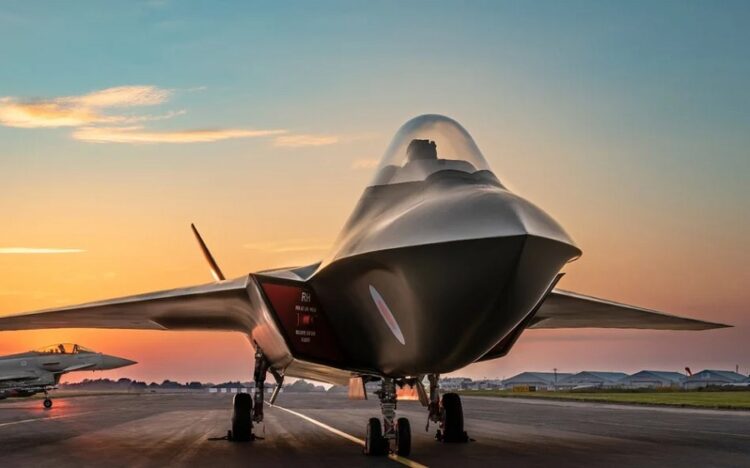This article is written by Major (r) Haroon Rasheed.
As geopolitical tensions rise and military technology evolves at an unprecedented pace, the world’s major powers are intensifying their efforts to develop 6th-generation fighter aircraft — cutting-edge warplanes that promise to redefine air combat. These next-generation aircraft are expected to feature stealthier designs, artificial intelligence integration, drone teaming, hypersonic capability, and network-centric warfare systems.
The competition for aerial supremacy is global, involving technological heavyweights such as China, the United States, Japan, and several European nations. Here’s an in-depth look at the ongoing developments around the world.
China’s Third Aircraft Carrier ‘Fujian (Type 003)’: A Giant Leap in Naval Power
PM arrives in Tajikistan on two-day visit
For more such Opinions & Blogs, click here.
China: Stealth and Innovation in the Skies
China has emerged as a key contender in the 6th-generation fighter race, with significant progress reportedly underway. Two major prototypes have been sighted, each developed by different defense aviation giants:
1. J-36 (Chengdu Aircraft Corporation)
Design: A tailless stealth configuration aimed at enhancing radar evasion.
Engines: A rare triple-engine layout — a unique approach potentially offering enhanced thrust and redundancy.
Capabilities: Designed with advanced stealth in mind, likely integrating electronic warfare (EW) systems, sensor fusion, and potentially autonomous operational support.
2. J-50 (Shenyang Aircraft Corporation)
Design: Twin-engine jet with V-shaped wings and a futuristic stealth-focused airframe.
Focus: Emphasis on speed, agility, and multi-role versatility.
Outlook: Likely to feature UAV teaming (manned-unmanned teaming or MUM-T) and AI-assisted decision-making.
Both platforms suggest China’s intent to leap ahead in air superiority, aiming to challenge Western air dominance through a combination of stealth, supersonic performance, and AI-powered mission execution.
Security forces kill five terrorists in Balochistan
“My Time Comes To An End’: Elon Musk Exits Donald Trump Government
“Contracts Signed, Systems Never Come”: Indian Air Force Chief Flags Delays
United States: NGAD and the Future of Air Superiority
The United States is pioneering the most ambitious 6th-generation fighter program under the Next Generation Air Dominance (NGAD) initiative. Designed to replace the F-22 Raptor, NGAD is not a single aircraft but a family of systems, including:
F-47 Fighter Jet (Boeing)
Contract: Boeing has been awarded the primary contract to develop the F-47, the Air Force’s next-generation fighter platform.
Features: AI-enabled cockpit, optional manning, enhanced stealth, and advanced electronic warfare capabilities.
Navy Variant: A carrier-based version for the U.S. Navy is also in the pipeline, reflecting the need for multi-domain operability.
The NGAD system is being designed to dominate in both contested and uncontested environments, integrating with swarms of drones, hypersonic missiles, and global surveillance networks.
Japan, UK, and Italy: The Global Combat Air Program (GCAP)
In an effort to share costs and advance common interests, Japan, the United Kingdom, and Italy have joined forces in the Global Combat Air Programme (GCAP) — a multilateral project to develop a 6th-generation fighter aircraft by 2035.
Objective: To replace Japan’s aging F-2 fighters and Britain’s Eurofighter Typhoon.
Technology: Emphasis on stealth, AI, cloud-based battle networks, and joint manned-unmanned capabilities.
Global Partnership: This marks one of the most ambitious international defense collaborations in aviation history.
GCAP symbolizes the increasing role of strategic alliances in developing next-generation defense platforms.
2nd T20I: Pakistan to face Bangladesh on Friday
Hilal Talks 2025 program launched by ISPR
Punjab CM directs to reduce price of roti across province
Europe’s Future Combat Air System (FCAS)
Meanwhile, France, Germany, and Spain are jointly developing the Future Combat Air System (FCAS), another major 6th-generation initiative expected to take flight around the mid-2030s.
Lead Developers: Dassault Aviation (France) and Airbus Defense (Germany/Spain).
Features: Highly advanced stealth, drone wingmen (remote carriers), AI-assisted combat systems, and cloud computing-based situational awareness.
Operational Scope: Aimed at replacing the Rafale and Eurofighter Typhoon fleets in the long term.
FCAS is not just about a fighter jet but a multi-domain connected warfare system, indicating how deeply digital warfare has become embedded in modern military doctrine.
A Global Shift in Military Aviation
The transition to 6th-generation fighter aircraft marks a paradigm shift in air combat. Unlike 5th-generation jets like the F-35 or J-20, these next-gen platforms are not just about stealth and speed — they are about data dominance, intelligent autonomy, and integrated battlefield awareness.
145 Million Afghani Distributed to Returnees Deported from Pakistan
Amid rising tension in region, India realigns troops in Ladakh facing China
Delhi HC reserves order on Shabir Ahmed Shah’s bail plea
Key Trends Across All Programs
Artificial Intelligence (AI) for autonomous mission support and real-time data processing.
UAV Integration (Loyal Wingmen) to perform high-risk tasks.
Network-Centric Warfare with seamless satellite, radar, and battlefield system integration.
Stealth Optimization with new materials and active camouflage systems.
Hypersonic Weapon Compatibility, drastically reducing response times.
Conclusion
A New Era of Aerial Strategy
As the development of 6th-generation fighter jets accelerates across multiple continents, a new chapter in global airpower is unfolding. From the Pacific to Europe, nations are investing in technologies that will shape the future of warfare for decades to come.
The next war in the skies won’t just be fought with speed and stealth, but with algorithms, drone swarms, and intelligent networks—a revolution where air dominance is defined by information as much as by firepower.
For more such Opinions & Blogs, click here.
Delhi Jama Masjid’s Shahi Imam Syed Bhukhari admitted in hospital
Youth Take the Lead at Chromatic’s 4th Annual Social Media Conference on Tobacco Control
India’s Ladakh Hydropower Plan Sparks Fears of Indus Water Crisis
PM arrives in Tajikistan on two-day visit
This article is written by Major (r) Haroon Rasheed.
Stay tuned to Baaghi TV for more. Download our app for the latest news, updates & interesting content!






